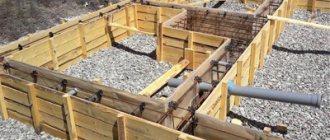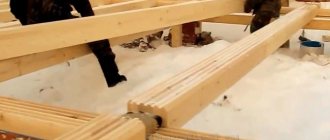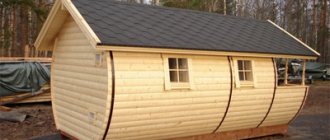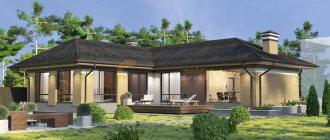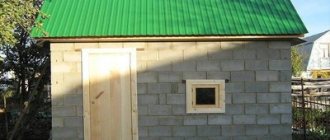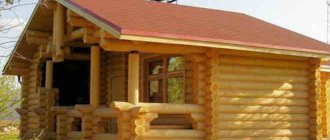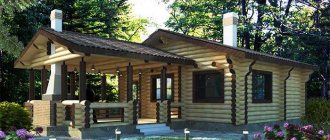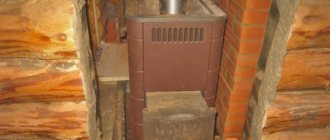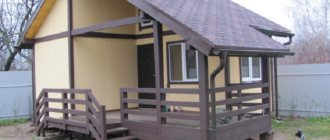Many buildings require a reliable foundation, so the owner of the house may need to build a foundation for a bathhouse; A brick bathhouse is a fairly massive structure, which means that the base must withstand the applied load.
Most often, a strip foundation is used for a bathhouse.
First you need to choose a place for construction and determine the type of soil. To do this, dig a pit 1.8 m deep and check the presence of groundwater. Analyze the type of soil - this will help you choose the right foundation for a bathhouse. Peat bogs, marshy and sandy soils are considered unstable soil types.
A good option in such cases is a monolithic or pile-screw foundation. You can also build a strip base with a sand cushion; it is better to replace the blocks in this design with monolithic concrete. Medium density soils are considered to be clay, loam, coarse sand, and fine gravel. In this case, you can use strip, block and pile foundations. Any type of foundation is suitable for rocky and quartz soils.
Taking into account the weight of the brick bath, it is recommended to choose a slab or strip type foundation, however, if the soil type is weak, it is better to choose the screw version.
Various sauna rooms
A classic bathhouse has three rooms: a steam room, a washing room and a relaxation room (often indicated as a dressing room).
The insulation of a brick bath in all these three rooms differs. The most powerful thermal insulation should be in the steam room. The average option is installed in the washing room, and in the rest room you don’t have to use special “bath” insulation schemes at all. Everything is done as in a regular living room, because the microclimate in the dressing room is the same.
Information. Not only the insulation layer differs, but also the vapor barrier. She should be especially careful in the steam room. Keep in mind that how long ecowool and other non-moisture resistant insulation will last depends on how well you did the waterproofing.
Steam room
Leaving just brick walls in the steam room is unacceptable. The wall structure will always be composite. A good option has the following layers in section:
- load-bearing brickwork walls;
- waterproofing layer;
- insulation layer;
- vapor barrier layer;
- external cladding of the steam compartment (lining, imitation timber, block house).
From these layers, the waterproofing layers between the brick wall and the insulation layer are sometimes excluded. Brick walls themselves, if they are built correctly and well waterproofed from the foundation, do not become damp. If you are not sure about the walls of your brick bathhouse, then be sure to install this additional insulation.
Technology for preparing concrete mixture for strip foundations
The required amount of sand is poured into the container, a depression is made in it and cement is poured in, everything is thoroughly mixed with a shovel. Crushed stone is added to this mixture and mixed well again. Then water is gradually added, preferably from a watering can, so as not to wash away sand particles with a strong stream.
In the garden plot there may not be containers on hand to accurately measure the required amount of material, so buckets are often used for these purposes.
Amount of material in one bucket (10 l):
- crushed stone - 15-17 kg
- sand - 14-17 kg
- cement - 13-15 kg
The amount of crushed stone depends on its fraction, the amount of sand depends on humidity, and the amount of cement is affected by the density of its compaction during backfilling.
Tips and tricks
When choosing materials for the interior decoration of a brick bath, pay special attention to comfort and benefits. For example, porcelain stoneware is cold, so that your feet are comfortable, you will have to wear shoes
Better comfort will be facilitated by the installation of special wooden pallets.
Unusual materials can be used to decorate the walls of some bathhouse rooms. For example, a high-quality and non-hazardous option will be made from natural stone. Special salt stones will provide greater benefits. However, judging by the reviews of the owners, this will require not only additional costs, but also careful consideration of the interior design.
The best option for decorating a bathhouse is wood. However, due to high humidity and temperature changes, wood tends to darken. If you notice this, do not be upset, it will not require repairs, this situation is considered normal.
How to insulate a brick bath
A brick structure like a bathhouse must be insulated. The air cavity formed by the brickwork is filled with the following mixture:
- 2 parts sawdust;
- 2 parts slag;
- 1 part fluff lime.
There is also a purchased option for insulation - tiled thermal insulation material. Its individual parts are attached to the walls from the inside using special fasteners and glue. In addition, insulation of a brick bath can be done from the outside, using polystyrene foam. As you know, the appearance of the external walls becomes unimportant after such manipulations, so you can disguise them with siding.
On the market you can find a huge number of versions of this finishing material, even stylized as wood. It is worth saying that finishing with foam plastic indoors is not possible due to its toxicity at high temperatures.
Mineral wool can be used as insulation for the foundation. The brickwork is equipped with wooden plugs, which are necessary for installing the slats.
A layer of vapor barrier is installed on top of this. To prevent your feet from feeling cold during bath procedures, you should cover the ground under the floor with a layer of expanded clay and slag.
Select for walls
A brick bathhouse and other buildings made of this material are built only in regions that have their own brick factory. This makes the material accessible and cheap. There are entire areas where brick buildings are rare. The point here is precisely the price of the brick.
Information. For brick walls, the foundation is always made larger than the thickness of the wall. Also, any brick partition in a bathhouse requires its own foundation. “Hanging” partitions like in wooden baths cannot be made here.
The choice of which brick is best to build a bathhouse from is made according to the assortment of the local brick factory. You can use any type of brick intended for walls and stoves. You cannot use facing bricks, as their strength is insufficient. This rule does not apply to all types of facing bricks.
Before purchasing a batch of brick, check its intended purpose. This can be done in the description of GOST or TU according to which this batch was released. Also, familiarization with the standard will allow you to check the compliance criteria.
How to choose a place for a bath
If you are determined to build a bathhouse, then for its construction you must choose a dry place. If there is a river or lake nearby, then the construction site should be at least 30 m away from it. Otherwise, during a spring flood, flooding or simply high humidity cannot be ruled out. In addition, fire safety requirements must be taken into account. If the bathhouse is heated with wood, the distance to neighboring buildings should be at least 12 m. If it is with gas or electricity, the distance can be reduced to 5 m. Of course, the bathhouse can be attached to any residential building, this will save building materials and simplify the installation of communications.
Parameters for choosing a foundation for a building
Most often, when constructing this structure, wooden beams or logs are used. These materials are relatively light, so the bathhouse will not be heavy.
Due to this, the building is best erected on a foundation consisting of a series of pillars buried in the ground.
These supports can be made of brick, pipes, wood, stone, foundation blocks or reinforced concrete.
Reference! The base of columnar supports is considered economical in financial terms, in terms of consumables, and in terms of construction time.
In addition, it is easy to install and will be suitable for any type of soil. Every novice master can build such a foundation.
If all stages of constructing a columnar foundation are carried out correctly, such a structure will be reliable and will last for quite a long time.
It is worth noting the disadvantages:
- Only low and light buildings can be erected on a columnar foundation,
- It is not suitable for unstable ground.
- this foundation is sensitive to horizontal soil movement, sudden cold snaps and floods.
In addition, the base does not allow for complete insulation under the building and arrangement of the basement. It is difficult to install communications into a building on poles.
General rules for brick construction
- The minimum wall thickness for a bathhouse is one brick.
- Each row is placed strictly level, observing the thickness of the seams;
- For the wall, bricks of the same batch and the same color are used (the exception is a predetermined decorative arrangement of multi-colored bricks).
- On a brick building, seismic belts made of reinforcement are required;
- Masonry mortar - not lower than M250-M350.
The plinth is placed on a concrete foundation slab. Rubble, concrete and brick foundations are suitable for a brick base. The option made of any material can be either strip or columnar. In any case, you need to build a foundation taking into account the weight of the bathhouse and the characteristics of the soil.
Calculation of bricks for the plinth
The calculation of a brick per plinth for its purchase and delivery is as follows:
- First, the volume of the brickwork is calculated. To do this, we multiply the perimeter of the foundation by the width of the masonry and its height. For example, the dimensions of the foundation are 4x3 m. with a foundation width of 300mm. The perimeter is 14 m. The masonry will be brick-width (250mm) and 4 rows high (70*4=280mm). We obtain the volume of the future masonry equal to: 14m*0.25m*0.28m=0.98 m3.
- In 1 m3 of brickwork, the average consumption of bricks is 400 pcs. We multiply our masonry volume by 400 pieces, we get: 0.98 m * 400 pieces = 392 pieces.
There are 300-330 pieces in a pallet (depending on the manufacturer). This means you need to buy 2 pallets. With reserve. The brick will remain, but it is never superfluous during construction. You can, in the future, make a simple brick grill.
Laying the plinth
The base is made somewhat thicker than the wall, but it is not necessary to adhere to this rule. The increase in thickness is done by half a brick. A higher value is not practical. Also, the base should not be made thicker than the foundation in the bathhouse. This will negatively affect the stability of the entire structure.
The foundation for a brick bathhouse is laid out in the same way as the walls. The sand cushion protects the foundation from soil antinodes. The bottom reinforced layer protects from failures. It is very beneficial to combine brick with concrete in the foundation. A concrete belt, which must be reinforced with long longitudinal reinforcement, will significantly add strength.
Laying concrete mortar
- The finished solution is poured into the formwork, leveled, pierced with a probe or bayonet shovel (to remove excess air), and tapped from the outside of the formwork with a wooden hammer.
- If it is possible to connect to the electrical network, then an internal vibrator can be used to compact the concrete mixture.
- At sub-zero temperatures, the strip foundation is covered on top with a film and a layer of sawdust or any insulation.
- After three days, the formwork can be carefully removed.
7. Construction of the base. After making sure that the concrete strip foundation is sufficiently strong, you can proceed to the next stage - constructing the base.
Consumables and tools
To build a foam concrete bathhouse, you will need to prepare the blocks themselves in the required quantity. It is better to take material with a reserve, since during the work there may be rejection.
Other materials will also be required:
- cement, river sand and water - for laying on a cement-sand mortar;
- dry glue in bags - for laying on an adhesive composition;
- reinforcement bars;
- wire for reinforcement;
- sewer pipes;
- fasteners: nails and screws;
- metal corners;
- windows and doors;
- Decoration Materials;
- materials for thermal insulation and waterproofing;
- antiseptic;
- wiring and lighting fixtures.
The tools you need to prepare are:
- drill with mixer attachment;
- buckets for mortar and glue dilution;
- Master OK,
- wide spatula with teeth;
- rubber mallet;
- hammer;
- perforator;
- roulette;
- building level.
Construction in stages
After erecting the foundation and leveling it, you can proceed directly to the masonry. This is an interesting business, and the work is not so physically difficult. Here's a short list of tools:
- Trowel, trowel for mortar;
- Bushhammer;
- Concrete mixer or hand-held construction mixer for preparing the solution;
- Level, plumb line, tape measure;
- An auxiliary tool for carrying mortar and bricks, such as a bucket.
For each item, you can purchase more advanced options. Instead of a level and tape measure, you can use a laser level and a rangefinder. Nowadays this electronics is inexpensive. With these devices, the accuracy of laying rows will increase significantly. The laser level is also useful in the construction of any other elements in the bathhouse. It is convenient to buy it in advance.
Important! If for masonry, in addition to solid bricks, you purchased ½ and 3/4 shares, then the mason’s hammer can be neglected.
One or more layers of waterproofing are applied to the leveled surface of the foundation. Both roll and liquid (mastic) materials are used here. How to make waterproofing - see other articles on our site.
The first row of bricks is laid on top of the waterproofing on a layer of masonry mortar.
This is done strictly according to the level. A cord is pulled across it. Before this, beacons should be placed in the corners of the bathhouse.
It is convenient to use wooden or metal bars as beacons. They must be firmly fixed to ensure a cord tension of several tens of kg. Brickwork in the bathhouse is done in one row. That is, they begin laying the next row only after the entire previous one has been laid out and checked for level and plumb.
First stage
Undoubtedly, the construction process begins with discussing the design of the future bathhouse with your family members. At this stage, it is worth determining the amount of finance that will be spent on construction, respectively, the choice of material, location, hiring workers, and so on. The most common option is a bathhouse with dimensions of 4*5 meters and an attached terrace. The choice is made in favor of brick as a building material. When building a structure with your own hands, it is worth studying several sources that describe the step-by-step technology of this process and studying the varieties, pros and cons of various types of selected building materials.
So, to build a brick bath you need to purchase the following materials:
- crushed stone, gravel, cement and sand;
- drain pipe;
- the brick itself;
- thermal and vapor insulation material.
What are screw piles
A screw pile is a type of support made of metal; during installation, it is immersed in the ground by screwing, without first drilling a well. This product consists of several parts: blades for screwing in, the main barrel and the tip. Visually it resembles a large screw. This design allows the pile to be easily screwed into the soil, further compacting it and thus increasing the load-bearing capacity.
Factory-made screw piles are produced with a special protective coating, which includes bitumen, enamel, and epoxy resin. A similar composition is used for anti-corrosion coating of underwater parts of sea vessels.
According to the calculation data and statistical information, when the pile is deepened to a level of 1.8 to 2 meters, its load-bearing capacity will be maximum.
Construction of a foundation for a brick bath
For our bathhouse we will make a reinforced strip foundation.
Before installing it, the building site must be cleared and the vegetation layer of soil must be removed. Laying out the axes and constructing the perimeter of the future foundation on the ground is carried out using a cord, pegs and a construction tape. All dimensions are taken from the design documentation. The trench for the foundation is dug 10-15 cm below the soil freezing level in your region. The bottom of the trench dug under the foundation must be filled with sand and gravel to a depth of 10-15 cm. Then it is compacted and a reinforcing cage with a rod diameter of 12 mm is installed in the formwork. To pass ventilation ducts into the future bathhouse, the foundation must be equipped with appropriate openings. They are cut out in opposite formwork panels and connected with a sleeve made of a pipe or wooden box. Naturally, all this happens before the formwork is poured with concrete.
Concrete is poured to the design level. After it hardens, the foundation must be covered with waterproofing and 3-4 rows of brickwork for the base of the bathhouse must be laid on top. In its last row we leave a hole for passing communications. We lay the drainage pipe under the foundation and extend it at least 5 m beyond its boundaries.
Solid brick can be used as a foundation for interior partitions.
Foundation reinforcement
The reinforcing structure is made of reinforcement with a thickness of more than 12 mm for longitudinal laying, and 6-8 mm for perpendicular and vertical laying. To make a reinforcing belt you will need: a grinder, welding wire, a welding machine and a tape measure.
The structure consists of more than four longitudinal, perpendicular and vertical reinforcing rods. The complete structure must be supplemented with formwork, and the finished foundation must rise 5 cm above the ground. Additionally, the corners must be reinforced, and the cut of the reinforcing belt must form a rectangle or square.
The next step in the process of making the foundation of a bathhouse is cutting the reinforcement to a certain length, after which the longitudinal and perpendicular rods are laid out on the ground and tied with wire at the points of contact. It is undesirable to weld the frame, because because of this there is a high probability that it will lose its integrity during the process of compacting the poured solution or during the operation of the finished bath in the future.
The longitudinal reinforcement is laid with an overlap of 30 cm and tied.
The gaps between the perpendicular and vertical reinforcement should be equal to or less than 50 cm. If a strip foundation with a width of 120 cm is laid, then it is advisable to make a frame that has not two, but three longitudinal reinforcing bars.
The same should be done if the foundation has a large height. In addition, in the upper part the frame should be reinforced with U-shaped clamps, which serve to increase the strength characteristics of the belt and minimize the chance of cracking of the strip foundation.
The frame in the corner parts must be supplemented with reinforcement placed at 45 degrees to the horizontal rods.
Partition in a wooden bath
This option is also quite possible. This solution is not particularly practical, so it is used mainly for design reasons. In this case there are two options:
- Made of facing bricks with a mandatory frame made of another material;
- Made of brick with a masonry thickness of one brick and on its own foundation.
Using facing bricks for an internal unplastered partition is more practical. Facing brick, especially if it is hollow, has low strength, so its masonry must be attached to some kind of foundation. A wooden frame structure is quite suitable.
A brick partition in a wooden bathhouse can be created with your own hands without special purchase of facing bricks. In this case, the masonry must be done in one brick, and the structure must be built on a stone or concrete foundation.
The thickness of one brick requires twice as much materials, but ordinary building bricks without external surface defects will do for them. Taking into account the price of facing bricks, a larger quantity of ordinary bricks can often cost less.
The choice of which brick is needed for the partition in the bathhouse is based on design and cost considerations. There is a great advantage to facing bricks. It comes in a wide variety of options.
In a wooden bathhouse, the thickness of the brick can be any. In a brick bath, it must match the dimensions of the main brick, which is used for laying the outer walls.
Types and sequence of wall masonry
The construction of brick walls should begin after waterproofing the foundation. For this purpose, roll materials such as roofing material, technoelast, glass insulation or various bitumen and bitumen-polymer mastics are used. Most often, walls are built using the single-row ligation system, since it is simple and can be installed alone without much difficulty. This design represents a change in spoon and butt rows of bricks. It is used when it is not planned to use the front layer of facing bricks.
For those who are not familiar with the technology of laying walls: a spoon row is a row of bricks that are laid with their side along the wall, and a butt row is laid with short ends to the outside of the wall.
There are three main types of brick walls:
- Continuous masonry, when bricks are laid in two rows without a gap between the rows.
- Masonry with a ventilation gap of 40–60 mm.
- Lightweight masonry. It consists of two walls, between which insulation is poured, be it expanded clay, fine slag or other analogues.
Most often, it is the third type of structure that is used, since it allows you to reduce the pressure on the foundation and save on building materials, since brick is quite expensive these days.
Solid masonry is no less popular, as it is more durable and reliable.
Regardless of the type of masonry chosen, they all start from the corners. First you need to lay out six rows of bricks on the mortar in the corners. A cord must be drawn along each row. They are wrapped around nails, which are inserted into the seams between the bricks at a distance of 3–4 mm from the vertical of the row. The cord helps determine the evenness of the masonry. A building level and plumb line are also used for this purpose.
If necessary, the base of the bathhouse should be laid out of solid brick, and the walls themselves should be made of hollow brick.
When laying, it is important to work quickly so that the cement mortar does not have time to set. If construction work is carried out in the summer, the brick is pre-moistened with water
The thickness of the layer of such a solution should be 2–3 cm.
There are several variations of solid masonry, including:
- "single-row"
- "multi-row"
They differ in that with a single-row laying there is a constant change of tying and spoon rows, and with a multi-row masonry system the tying rows go through 5-6 spoon rows.
When laying bonded rows, it is necessary to apply the mortar with an indentation of 10 mm when filling joints and by 30–35 mm when laying waste areas. If you have bricks lying around with any defects, do not rush to throw them away; it is better to use them for laying tray rows, in addition to corners and support areas.
Internal load-bearing walls must have a thickness of at least 20 cm. Transverse walls usually consist of halves or quarters of bricks. If the length of such a partition exceeds 1.5 m, then they must be additionally strengthened with a reinforcement belt every three rows.
Door and window frames are installed directly during the masonry process. Wooden blocks as thick as bricks are installed in the side parts of the openings. They are wrapped in a layer of roofing felt and tarred.
Ventilation holes must also be provided here. Usually in such baths a supply and exhaust ventilation system is installed. It consists of two holes: one regulates the air flow, the second is the exhaust hole. The first is best placed under the bottom of the stove, and the second is as far as possible from the heater, 7–8 centimeters below the ceiling level. You can also provide special dampers that will help regulate the air flow in the steam room.
Designing a brick bath
When designing a brick bathhouse, understand the purpose of the future building. It is clear that it is needed for taking hot steam and water for health purposes. But besides this, you can have a good time in the bathhouse. Therefore, in addition to the dressing room, wash room and steam room, a relaxation room will be very useful. If your financial capabilities allow, plan to build a font or pool for your bathhouse. If there is a shortage of living space in the house, you can plan two floors or an attic in the bathhouse. Another important point is to determine the required volume of each of the premises of the building. For example, the steam room should not be made the largest in area, since the duration of stay in it is short. A relaxation room should be used for relaxation and tea ceremonies - make it larger to comfortably accommodate the required number of adults at the same time.
Pay attention to all the important aspects of the brick bathhouse project:
- The windows of the bathhouse should be oriented to the west, this way you can save on its lighting.
- The entrance is from the south. In winter, there are usually fewer snowdrifts near it, which will melt faster in the spring.
- According to SNiP, the bathhouse is located no closer than 3 m from the fence, so that in the event of a fire it can be accessed from all sides.
- For a steam room, the optimal dimensions are from 2.5x2.5 to 3.5x3.5 m.
- The door to the steam room is made with a threshold height above the floor of 30 cm and has a size of 1.7 x 0.6 m.
- The steam room window always opens outward, is located a meter from the floor and has a size of 40x50 cm.
- The shelves are made 70-80 cm wide with a height from the floor of 75 cm. There should be a distance of 105 cm from the top shelf to the ceiling.
- It is better to place the stove with the firebox in the dressing room, and the stones in the steam room.
- The door between the dressing room and the washing compartment has dimensions of 1.7 x 0.6 m.
- All sauna doors should only be opened outward, as safety precautions say.
After design research, we proceed to a practical solution to our question of how to build a brick bathhouse.
How to make a partition
When designing a bathhouse, you need to decide what partitions will be made in it: wooden or brick. A wooden partition is cheaper than a brick one and does not require such good thermal insulation. It is used quite often in brick baths.
There is no need to specifically choose which brick is needed for the partition in the bathhouse. Simply buy in bulk the same option as for external walls. An exception may be an interior design project, when the brick partition will not be insulated and will remain unplastered in the interior. Then you can buy a special type of brick for it with the desired texture and color.
Moreover, any partition in a brick bath with your own hands must be connected to the walls. The best solution is to lay the partition together with rows of external walls. Reinforcement is also required.
Information. If you decide to make a wooden partition, then it is erected after laying the walls, building the floor and roof. How to build wooden partitions, read the articles about wooden baths on our website.
Design
When designing a bathhouse yourself inside, do not forget about the rules. The main rule is compliance with fire safety standards. For example, wooden and other flammable objects should be kept at a meter distance from the stove. The interior decoration of the bathhouse should preferably be natural and environmentally friendly. Therefore, you should not use a budget plastic alternative, which can be painted to look like wood. Despite the monetary benefits, plastic is not practical, since it does not allow vapor to pass through. In addition, under the influence of steam and temperatures it will release harmful substances.
If you want to save money on the inside of a brick bathhouse, you don’t have to decorate it with anything at all. Modern bathhouse design sometimes involves the use of finishing bricks to decorate the walls. The best option for inexpensive finishing of a bathhouse is wood. It requires minimal skills in working with tools; such finishing will not be difficult. If we consider in more detail, it is better to read the design of the bathhouse from the dressing room
When choosing options, it is worth considering that people relax in the room after water procedures, so it is important to provide the most comfortable functionality inside
For example, a full wardrobe, as well as places to relax. Standard set of necessary items: table, benches, wardrobe. The wall finishing material and furniture color can be chosen to suit your taste.
A standard steam room includes: a heater stove, shelves, which are usually built at different levels. The steam room is a very important room for a bath. Arrange shelves according to individual preferences. The higher the shelf, the hotter it will be.
If the shelves and walls of the steam room are decorated with wood, then the place near the stove must be brick or, as an option, natural stone. If the washing room is a separate room, then it also requires a designer approach to design. A standard shower room must have benches, a shower or a tub of cold water (as before, in a Russian bath). The shower room does not necessarily require wood finishing. Decorative tiles or wall panels are suitable as finishing materials.
Possible options for bricks for walls from modern manufacturers
- Classic red brick (suitable for walls, stoves and foundations).
- Sand-lime wall brick (there is no firing in production, instead the autoclave method is used).
- Ceramic brick with pigments (a very preferred option for unusual designs).
- Ceramic brick with a decorated outer edge (similar to paving stones).
- Hollow-core wall bricks (for good thermal insulation - the best option).
The price of a brick is determined by the manufacturer, as well as the production technology used. A bathhouse made of sand-lime brick will be cheaper than one made of red brick. Classic sand-lime brick is white. This option is not very suitable for a bathhouse. In production, it is possible to add any mineral pigment to the mixture.
That is why almost any manufacturer offers a wide range of brick colors. For silicate it will be even greater than for red, since firing is not used in its production, and the heat resistance of the pigment is not necessary.
The strength of the walls is determined not only by the brick for the bath; what kind of masonry mortar to use is also of great importance. It's easier with his choice. It is necessary to use only cement-sand mortar mixed to a strength of at least M300.
For laying brick walls and partitions, you need not only solid brick, but also 1/2 and 3/4 shares. Previously, they were made by splitting solid bricks, but now many factories allow you to purchase them ready-made. With the use of such ready-made shares, the masonry is much neater.
Information. In a two-level bathhouse, it is advisable to rest the beams on a concrete belt rather than on bricks. It is not necessary to do this in a single-level bathhouse.
Selection of design option
A do-it-yourself brick bathhouse can be built on a strip or columnar foundation. Pile screw structures are not used due to the heavy weight of the walls. A strip or column foundation can be made of the following materials:
- Concrete slab, precast concrete products, such as standard foundation blocks;
- Concrete casting (concrete foundation);
- Brick or stone masonry.
All these materials make it possible to produce both columnar and strip foundations of any scale. Reinforced concrete provides the greatest strength.
A prefabricated foundation made of concrete blocks is built faster, but its strength is less than that which is cast on site. Monolithic construction is the most reliable option. It is quite often used in private low-rise construction.
You need to cast such a foundation yourself.
The technology is simple: a trench is dug around the perimeter of the walls of the bathhouse, a sand cushion is poured, reinforcement is laid and concrete is poured.
Before pouring, formwork is placed in the trench. For casting, it is advisable to use a mortar for laying bricks in a bath with the addition of crushed stone.
Information. In any type of foundation, attention must be paid to a strong longitudinal connection. The best option is to lay reinforcement around the perimeter of the building. Calculated cross-section data are given in the design documentation.
The foundation is placed not on the ground, but on a sand cushion. It was made in order to prevent antinodes of the soil. In this case, it plays the role of a kind of shock absorber.
The outer surface of the foundation after pouring, if it is concrete, or masonry, if it is brick, is carefully leveled strictly to the level. This will be the foundation on which to lay the brick in the bathhouse. The first row is laid out on a layer of good waterproofing.
How to build a strip and monolithic base?
This type of foundation is most often used in the construction of brick and stone baths. Despite the simple design, such foundations for baths require a lot of labor. The installation depth is determined based on the freezing depth; the base is laid 20 cm lower. For construction you will need the following materials and tools:
Scheme of a prefabricated and columnar monolithic foundation.
- sand;
- crushed stone;
- shovel;
- concrete solution;
- wooden formwork;
- roofing felt;
- bitumen;
- reinforcing bars.
The site must be leveled before construction, after which they dig a trench 75 cm deep. The foundation for the bathhouse must have a width 50 cm greater than the thickness of the walls. A sand cushion 15 cm thick is formed at the bottom of the trench. After this, the same layer of crushed stone is poured in and the cushion is compacted. Now you can pour the concrete solution, which is reinforced with large stones. Then a formwork 20 cm high is built and the ground part of the foundation is poured with concrete. You can form this part using brickwork with your own hands.
Construction of a brick strip foundation.
The top of the foundation is leveled with a concrete screed, the base is insulated with 2 layers of roofing material coated with bitumen mastic. A base of stone, brick or foam blocks is built on top of the waterproofing. It is recommended to prime or plaster the surface of the blocks. This is due to the porous structure of the material, which absorbs moisture. Ventilation holes are made in the base. A blind area is built near the walls of the bathhouse, which helps protect the base from the effects of rain and melt water.
The most reliable and at the same time expensive option is a monolithic base. It is used in the construction of baths of any size. A solid reinforced concrete structure can have either a ribbed or flat base. A foundation for a bathhouse with a ribbed base is considered more durable; trenches are formed in the ground for the ribs, into which concrete mortar is poured. A sand or gravel cushion is placed between the ribs, after which the foundation is poured. This option is well suited for weak soils due to its solid design. After completion of construction work, the foundation is thermally insulated.
Composition of concrete mixture per 1 cubic meter. m.
- medium crushed stone (fraction 20-40 mm) - 1900 kg. clean sand (content 5%) - 1140 kg.
- Portland cement PC 500 - 380 kg.
- water (from a well or tap) ~ 172 l.
The required amount of concrete mixture can be easily calculated based on the size of the future strip foundation. In our case: height - 0.3 m, width - 0.3 m, length - 19 m (6+2+2+6+3). Therefore, we need V=0.3×0.3×19=1.71 cubic meters.
In our case, construction work was carried out when the air temperature at night dropped to minus 5°C, so we additionally used the anti-frost plasticizing additive “Benotech PMP - 1”, which is sold in liquid form. At temperatures from 0 to −5°C, it is necessary to add 1% additive by weight of cement to the concrete mixture. The amount is calculated based on the mass of dry matter, of which one liter of additive contains approximately 453.4 g. At 380 kg. Portland cement requires 8.38 liters. additives.
You can use another additive that accelerates the hardening of the concrete mixture and has antifreeze properties.
If it is possible to connect to the electrical network, the concrete structure can be heated using heating formwork, which uses heating cables, heating elements, mesh heaters and other heating elements. In addition, the concrete mixture can be heated to a temperature of 40-60 °C before laying.
Advantages and disadvantages
Of course, there are no ideal building materials. Therefore, brick, like any other material, has its advantages. Let's look at them below.
- Durability. With proper installation and operation, such a building can be used for more than 100 years!
- Environmental friendliness. When heated, brick does not release any chemicals.
- Fire safety. The likelihood of a brick bath igniting is almost zero.
- Design. Since the brick structure is very stable, it is possible to build a structure of various shapes and sizes, create an unusual, interesting layout, and so on. In addition, the brick itself, if the external walls are built for decorative purposes, looks quite attractive and solid.
- Brick does not rot and is not susceptible to fungus and other microorganisms.
- The shrinkage period of a brick bathhouse is much shorter than that of a bathhouse made of a wooden frame or timber.
There are also a number of disadvantages.
- High cost of material. A very contradictory opinion of the majority of inexperienced masters. In fact, the differences in price when building baths of the same size and the same design are minimal.
- High heat capacity. It will take several times longer to warm up a brick sauna than to heat the same wooden sauna.
- High thermal conductivity. Brick conducts heat and cold well, but this problem can be solved with high-quality vapor barrier.
- Hygroscopicity. Brick walls can absorb moisture, which will inevitably lead to deformation and destruction of the walls. The problem can be solved by installing a layer of waterproofing.
- Due to low vapor conductivity, bricks tend to change color and collapse. Good vapor barrier and ventilation will save you from this.
Window and door openings
Even in the most compact bathhouse, windows must be installed. One of them must be placed in the steam room, and it must open. This will be a backup option for quick ventilation. Openings for windows and doors are laid out the same way. Laying a partition in a brick bathhouse also implies a doorway. The thickness of the outer walls of the bathhouse is at least one brick, and preferably one and a half.
When laying one and a half bricks, ¾ shares are needed to create even edges. It is convenient to purchase them at the factory along with the main batch of bricks, but this is not always possible. In other cases, they use a mason's hammer and split the brick themselves. The split side is always located inside the seam. The outer sides of the opening are neat and clean.
Information. There is no need to make lintels for window and door openings if a seismic belt is located at this height. This solution is very convenient in the design of any buildings and allows you to save materials and labor costs for construction.
Not all window lintels can always be connected to a seismic belt. In this case, they are made additionally. Wooden lintels cannot be used for brick walls. They are short-lived and will not be able to support the weight of the brick on top of the window. Only reinforced concrete and steel lintels are suitable. Reinforced concrete ones are cast in advance in wooden molds.
The technology here is standard; you just need to take into account the thickness of the brickwork of your bathhouse. The average thickness of the lintel is ¼ brick. For any thickness it must be a multiple of this value. In this case, it will be easy for you to build a lintel into the brick rows. A common option is to use ready-made lintels obtained from a reinforced concrete products factory.
Peculiarities
One of the options is brick, using which you can implement any bathhouse project with your own hands. Check out the pros and cons of a brick bathhouse, and also study the construction instructions. So that you have the best understanding of the features of a brick bathhouse, consider the fundamental advantages and disadvantages of the material used in construction. Advantages of brick:
- Excellent fire resistance. The fire safety indicators of brick are the best in comparison with other materials.
- Long service life. A brick bathhouse can last up to 50 years, or even more.
- Environmental friendliness. Different types of natural bases are used for bricks. Brick is considered safe for humans.
- Large selection of architectural solutions. From brick you can build not only simple boxes, but also bathhouses of more complex shapes.
Disadvantages of brick:
- Increased heat capacity. Heating a brick sauna will require more fuel than a wooden sauna.
- High moisture absorption. Brick is a hygroscopic material and therefore requires careful insulation.
- Significant price. Brick is not a cheap material, so the bath structure will be expensive. For the construction of a bathhouse, it is allowed to use only red brick, which is distinguished by its long service life and increased resistance to heat.
- One more nuance: a brick bathhouse will require the construction of a stronger foundation.
During construction, it is possible to use several wall design options. For example, well masonry is considered an acceptable option, which allows you to install insulation inside the wall. Another rational way is to build a thin wall with the installation of high-quality insulation on the outside.
The most unsuitable masonry system for a bath structure is the continuous type. Such a bath will require the construction of very thick walls, which will lead to waste of material. In addition, the operation of such a bath will be possible only in the summer.
"Ski"
This term means a foundation, which is one monolithic slab, the area of which is equal to the area of the lower floor of the bathhouse. This option is often recommended for private houses and baths. It is durable and reliable, but requires a lot of materials.
The use of “skis” allows you to radically reduce the load on the ground.
Each brick wall in the bathhouse will distribute its weight over the entire surface of the slab. This cannot be achieved with a columnar or strip foundation.
